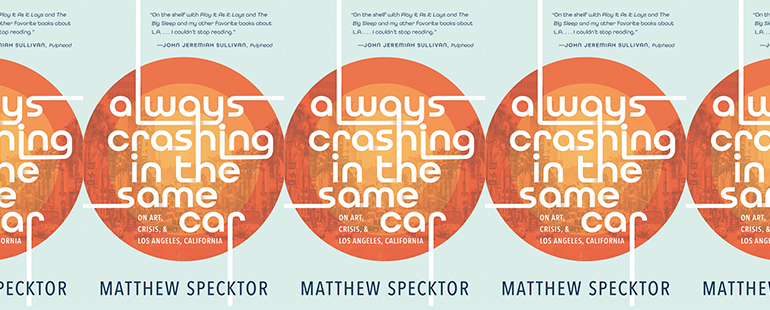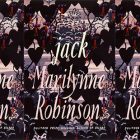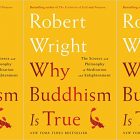Matthew Specktor’s Tender Ode to Failure in Always Crashing in the Same Car

Always Crashing in the Same Car: Art, Crisis, and Los Angeles, California
Matthew Specktor
Tin House | July 27, 2021
In Always Crashing in the Same Car: Art, Crisis, and Los Angeles, California, Matthew Specktor uses movies and Los Angeles as a lens to examine his life. Each chapter profiles an artist—Carole Eastman, Tom McGuane, Tuesday Weld, Warren Zevon, among others—whose fascinating accomplishments, excesses, and tragedies are used as an anchoring device to parallel or contrast with related themes in Specktor’s own life. The result is an unflinching, honest account of Specktor’s life, as well as a tender ode to failure.
Through the filter of Hollywood stories and films, Specktor confronts his career disappointments, failed marriage, a good friend’s likely suicide—a slant approach that softens the pain of loss and provides a cushion for vulnerability. Writing about the award-winning film Coming Home, Specktor asks, “Is it wrong to see in this film’s bookends a family history, my own unavailable life rendered legible to me? . . . Assuredly, yes, but it’s all I have. And this is why we make—and consume—art in the first place.” For Specktor, it is easier to deal with personal abandonments and emotional wounds when they’re on a 50-ft. high movie screen, with perfect cinematography or in a re-mastered song, or even on the edited page. The distance allows the space, the breath, the emotional openness to confront one’s life and to finally release regrets. It also allows Specktor to be clear-eyed about his own frailties and mistakes, one of the many aspects of his voice that make this book so layered and readable.
Movies are a natural framework for this task, a language Specktor speaks fluently, as well as a source of connection with his parents, even when actual communication was a challenge or virtually non-existent. For example, investigating Eleanor Perry’s career arc brings memories of the author’s talented but troubled mother, their difficult relationship, and the rapprochement of sorts in her later years. “I cannot help but wonder (this, too, reminds me of my mother)” he writes, “whether her modesty didn’t work against her. If along with her talent came a corresponding impulse toward self-erasure.” Through examining Perry’s life, Specktor grasps a clearer sense of his own mother.
Though Specktor shares the biographies of well-known artists to write about people in his own life, the well-known and the personal stand apart. In sharp contrast to the bold-faced names of artists throughout the memoir, when referring to the individual relationships in his own life, his ex-wife, daughter, friends, Specktor uses a first initial. Here, he offers the privacy that is lost to the famous in Hollywood, whether by choice or consequence. It’s a way of subverting the drive for external recognition—the literal “do you know who I am”—into a more intimate, and meaningful human engagement. Unlike the bold-faced names in this book, through press junkets, and in gossip magazines, these personal relationships—for all Specktor’s candor—are still discreet, and protected.
Along with writing about people, Specktor also examines himself through the city of Los Angeles itself. The city is his broad canvas and an exquisitely drawn character. He poetically describes the complex, oft-misunderstood West Coast metropolis: “One thing about Los Angeles . . . this city is small . . . As a municipality, of course, it is massive, with at least eighty-four neighborhoods spread across 503 square miles . . . It is, in essence, a proletarian place: pretty but seedy, down-at-the-heel but also a little hopeful, like drinking a cheap mimosa on a hotel terrace where one can smell, always, the distant traces of last night’s vomit.” The memoir can be described the same way, traversing diverse temporal and topical ground. Specktor examines and embraces the grittiness of his own experiences, calling out the consequences of fame that may far exceed the ephemeral rewards. In doing so, Specktor takes control of his own narrative, and what constitutes his personal happiness: to focus on knowing the self versus being “known,” whether through celebrity or notoriety.
A critical leitmotif of the memoir is this exploration of fame and (relative) obscurity: “What makes a writer fall silent? It is a funny question to ask, at the end of this book which is about writers, and filmmakers actors, and musicians who have done exactly so, whose careers have been aborted or abridged by one thing and the next.” Specktor writes plainly about the real Hollywood behind the imposing yet two-dimensional sign that stands for its grandeur: the broken dreams, those who are no longer followed by the spotlight, by the flash of a paparazzi’s camera, if they ever were. Specktor’s memoir questions the modern perversion of the American Dream and its ceaseless gluttonous drive for success and fame, for more, always more. If our achievements are never enough, he suggests, then we are never enough.
Reading this memoir feels like a rapt movie-binge at the Biographic Cineplex. As the memoir progresses, the parallels and intersections increase, as well as the unexpected connections. What one discovers about Hal Ashby or Michael Cimino or Renata Adler through the eyes of a passionate and knowledgeable insider is compelling, yet what echoes long after the credits roll is the intimate investigation of one man’s imperfect life, the successes and failures, and most importantly, the realization that who we are now is everything.



